
|   |

|   |
 e-mail: leelakaverivenkat@gmail.com Moments of movement and melody from Music Academy's mega dance festival Photos courtesy: Madras Music Academy January 23, 2025 It was Madras Music Academy's 18th dance festival - a mega event featuring thirty two dancers over a week! One took in as much as a strained back, thanks to hours of couch potato sitting, would accommodate. 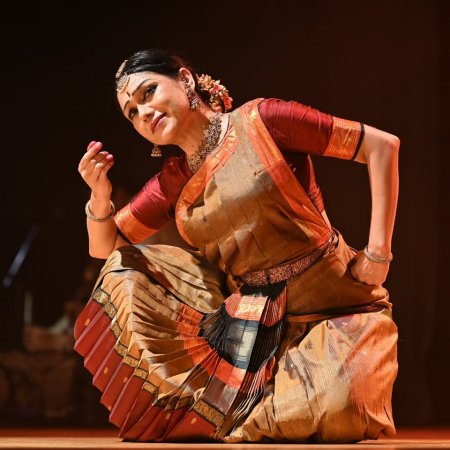 Rama Vaidyanathan Rama Vaidyanathan, trained under the recently departed Yamini Krishnamurthy and Saroja Vaidyanathan, heralded a start with an invocation based on words from Tirumular's Tirumanthiram, one of the key texts of Shaiva Sidhanta. Also known as Sundaranathar, Tirumular's verses form part of the twelve volumes of Tirumurai - a compendium of songs by various poets, in praise of Shiva. The selected verse urged the devotee to look for and sense the divine presence, constant in the minutest of objects of this world. The dance depiction along with the Ta Nom syllables woven into the music composed by S Vasudevan (whose nattuvangam provided a special element of vibrancy) made for a lively start. From devotion to sringar, the warp and woof of the dance, was the varnam by Shyama Sastry (mainly a Devi Upasaka) Sami nee rammanave in Anandabhairavi, dedicated to Varadaraja Perumal of Kanchipuram. The Nayika, consumed by her love for Varadaraja Swamy, urges the sakhi to convey to the Lord the urgency of her love, and the dancer in her sanchari, cites the unrequited fire of the Nayika's desire, reducing to ash, even a flower offered to her. The nritta punctuations, always a strong aspect of Rama's Bharatanatyam, comprised jatis by Sumod Sreedharan who provided mridangam support. Vocal support was by Kartik Hebbar, who had scored the music for the Abhang in raga Jog, of a composition of Sant Janabai who belonged to the Vaarkari sect of Maharashtra. While working in the house of Namdev's father, she sings her compositions addressing her God Vithala, revealing the frankness of a woman who has no use for coyness and has little to hide. "I will remove my veil, sing and dance revealing my whole self." She boldly says to Vithala, "I am the courtesan and you are my customer!" 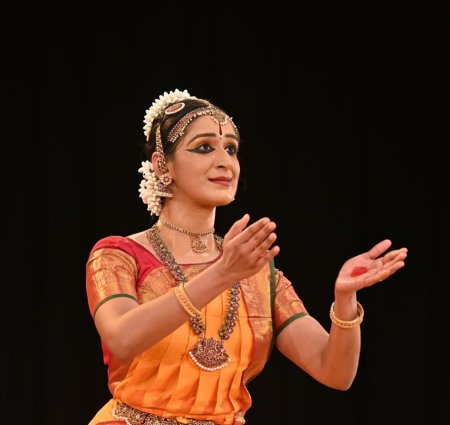 Bhavya Ramachandran Meriting the 2019 M.N. Subramaniam Memorial Prize, in the Dance Festival of the Music Academy, apart from other distinctions, Bhavya Ramachandran, who completed her advanced learning in Natyasastra with Nrithyodaya, Dr. Padma Subrahmanyam's institution, gave a neat recital, based entirely on Dr.Padma's dance visualization, with many of the musical items too being the Guru's own creations. Starting with the Pushpanjali comprising a hymn from Tevaram, in Nattai set to chatusra ekam, the dancer moved on to Padma Subrahmanyam's Jatiswaram composition in a Ragamalika, after which Bhavya presented Tyagaraja's pancharatna kriti Endaro Mahanubhavulu in Sri ragam. The post centerpiece mimetic section, after Ghanam Krishna Iyer's Yaar poi solluvar, featured the Ashtapadi in Purvi, Sa virahe tava deena, showing the sakhi pleading the case of Radha with Madhava, by giving a description of the pitiable condition Radha is in, pining for Krishna's presence. To round off was the Tillana in Kanada, again a composition of her Guru. With Dr. Gayatri Kannan's vocal support and nattuvangam, Nagai P Sriram was on the mridangam with flute and violin played by B. Gokulakrishnan and Sree Lakshmi respectively. DASHAVATARAM 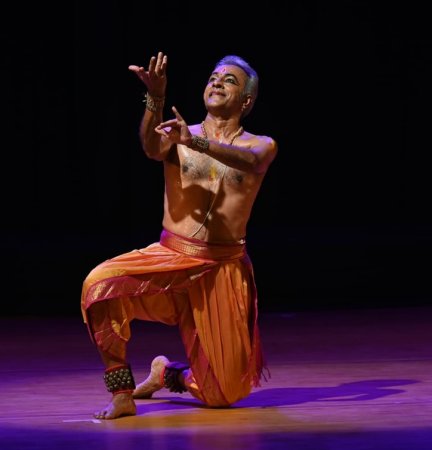 G Narendra Witnessing Bharatanayam by G. Narendra, founder director of Avigna Dance Ensemble, after the space of several years, one was amazed at the stamina of his Dashavataram - with neatness of line and profile in the Kalakshetra manner, not wilting the slightest bit with the years. While depiction of the ten incarnations of Vishnu does have its inbuilt element of theatre, to keep the dramatization within the aesthetics of dance without going overboard, requires a discipline which was evident in Narendra's case. Adding a specially electric element to the overall effect was the nattuvangam by K. Mahalakshmi. With G.R. Praveen providing vocal support and experienced artistes like Kalaiarasan, Devarajan and Ananta Narayanan for violin, flute and veena accompaniment respectively, the wing support was well rehearsed. SUPREMELY AESTHETIC GROUP PRESENTATION OF MARGAM 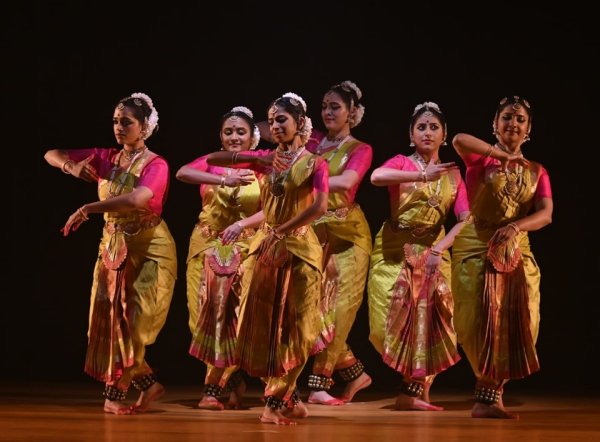 Sankhya Dance Company Nibandhana choreographed by Vaibhav Arekar as a Sankhya Dance Company group production, charmed the audience with the imaginative presentation of the Bharatanatyam Margam which is essentially devised for a solo presentation. Known for his refined sense of aesthetics, Vaibhav, assisted by co-director Sushant Jadhav's lights and sophisticated eye for costume colour combinations on stage, what was presented, along with the dance excellence, became a feast for the eyes. From enveloping the sky in Om Akasa Vidmahe to the other elements and moving on to that metaphor for cosmic movement, Nataraja in Ananda Nadana Prakasham in Kedaram, came the Ragamalika Jatiswaram by the Quartet, after which was the Ponniah Pillai varnam in Bhairavi, Mohamana en meedu. The smooth manner in which groups in twos, threes or fours came together or just melted away into a single dancer, had to be seen to be believed. The passionate intensity of the ashtapadi Priye Charusheele, wherein Vaibhav as Krishna kneeling and pleading with Radha while declaring his love and calling her his ornament and his life's breath, brought tears to the eyes. Balamurali Kishna's Tillana in Brindavani came as a vivacious nritta finish to what was ensemble dance at its best. Full marks to an excellently finished team of dancers with Vaibhav leading, Eesha Pinglay, Sruti Menon, Shruti Ranade, Poorva Saraswat, Mrinal Joshi, Radhika Karandikar, Devayani Samant, Anu Christy and Gautam Marathe. Kalishwaran Pillai's nattuvangam, with mridangam by Dakshinamurthy led the pure dance passages while the mimetic passages had Karthik Hebbar's singing (with emotive appeal despite the voice, as can happen, hitting the odd off-key moments) with Vishwesh Swaminadhan on violin and Jayaram Kikkeri on flute. VARNAM IN NEW PERCEPTION 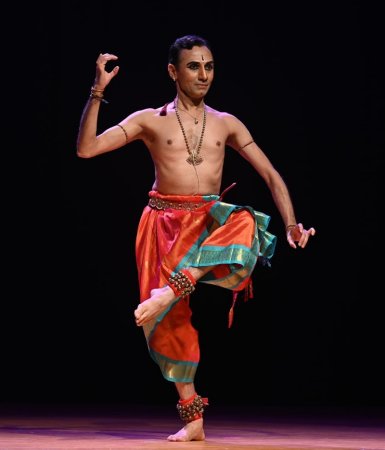 Praveen Kumar One of the artistes featured regularly in Music Academy's annual festival, P. Praveen Kumar, who mastered his craft under Gurus like late Narmada and the recently departed Prof CV Chandrasekhar, has been working on time honoured compositions of the Margam, trying to look at them in a fresh perspective. And in Tanjore Quartet's Ashtaragamalika varnam Sami ninne kori, his interpretation perceives the Nayika's love for the God having its beginnings in childlike curiosity displayed in the abstract representation of Shiva - in the Lingam as her play thing, graduating to a feeling of fondness and deeper feelings for the God, before finally blossoming into the fire of full blown sringar, yearning for the Lord. Well rehearsed, one liked the punctuations and little touches coming from the wings, with an experienced singer in D.S. Srivatsa. Mridangam by Vidyashankar N, as also flute and violin by Mahesh Swamy and Mandya Nagaraj also combined in adding to the total effect with small interventions. Kanakadasa's Baro Krishnaiyya treasured for the Ragamalika music alone, was an appealing item before the dancer concluded, in a fitting tribute to his Guru, with CV. Chandrasekhar's Tillana in Keeravani. Very creditable that his student Navyashree provided such able nattuvangam support. LUCKY BREAK FOR NAVIA 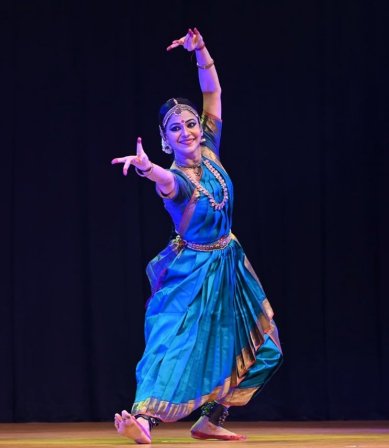 Navia Natarajan Lady Luck blessed Navia Natarajan whose last minute inclusion in the festival was to fill the gap caused by the indisposed dancer Malavika Sarukkai's dropping out. Sympathetic to the problems of finding accompanying musicians, already in great demand during the festival season, authorities allowed the dancer to perform to recorded music, which comprised vocal support by Raghuram Rajagopalan, nattuvangam by Prasanna Kumar, mridangam played by Harsha Samaga with Keshav Mohan Kumar on the violin. Sushant Jadhav, as for several other artistes in the festival, was on the lights. One must acknowledge Navia's making full use of this undreamt of opportunity. Starting with verses from Sri Haristhotram by Swami Brahmananda and Srimad Bhagavatam (resource person being Shankar Rajaram) set to music by D Srivatsa, the dancer went on to the Tana varnam composed by Kunrakkudi Krishna Iyer Kamakshininni koriyunnadira in raga Kambhoji, set to misrajhampe talam. The Sakhi here addressing the king, pleads the case of the Nayika, who she says is the ideal mate for him with her beauty and love nurtured over years. She urges that he go to meet her. Apart from the conviction in her abhinaya, Navia showed an uncanny feel for space, covering the entire stage with ease, radiating a sense of a fully occupied performance arena, with absence of the live musicians not felt. The dancer, during the announcements for this varnam, acknowledged guidance provided by Dr.Anupama Kylash and Prof Raghuraman. Biting in its restrained interpretative skill, this critic particularly liked the recital being culminated with the presentation of Draupadi - The Agniputri based on verses taken from Subramania Bharati's Panchali Sabatham, with some of the Tamil verses written by Prof Raghuraman and music scored by Raghuram Rajagopalan. First presented as an Usha R.K. production as a part of Vanita, a two day Samvaada on the characteristics of exemplary woman in Indic wisdom, the proud bearing of Draupadi questioning the right of using her as stake when Yudhishthira had already lost his kingdom and her veiled contempt for five supposedly valiant husbands being unable to defend her during her humiliation in the Kaurava court, were brought out without needless theatrics. There was none of the usual scene of Dushasana dragging Draupadi by the hair, pulling her robe and finally submitting to defeat while trying to disrobe her. The dancer wincing, holding on to her head with a pained expression was sufficient to convey what was happening - for after all abhinaya is the craft of suggestion more than an actual portrayal. And then came the final curse in menacing calm, of not putting up her loose hair, till it was anointed with the blood of Dushasana. YOUNG MALE TALENTS 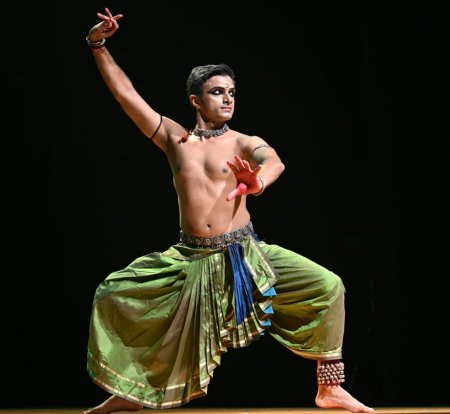 Parshwanath Upadhye Unlike in the past, the last few years have seen the dance scene producing plenty of young male talent. Now an established artiste, Parshwanath Upadhye, whose performance this critic was not able to witness, one hears attracted a full Music Academy auditorium with even the balcony seats occupied! Of the very recent entries, one was deeply impressed by two young male dancers. 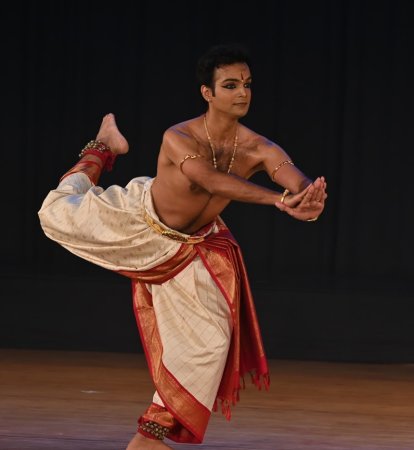 Bhavajan Kumar Bhavajan Kumar, a shishya of Leela Samson and Jyotsna Narayanan, and a lead dancer of Spanda Dance Company, radiates a special quality of inner calm, from which the dance takes off. So whether it is the varnam in Ragamalika Atkolla vendum ayyane with lyrics of G.Vijayaraghavan set to music by K.Hariprasad, or a Sant Tulsidas Bhajan in Desh, Kapi se urin ham nahi, the interpretative part is invested with an added dimension of fervour. As for the nritta part, it is characterized by impeccable lines. 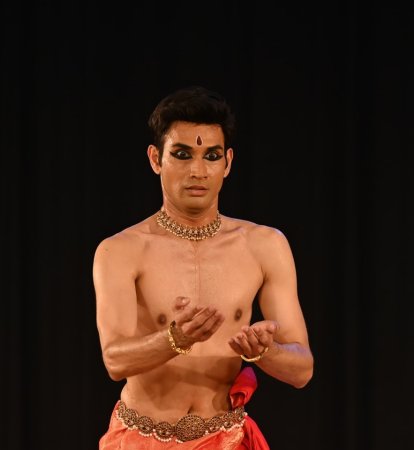 Avijit Das The other male dancer, who stood out, in the festival was Avjit Das, the Kuchipudi performer, now under Jai Kishore Mosalikanti and Padmavani, after being trained under Vedantam Ramu and Srimayi Vempati at Kuchipudi Art Academy. As one who has academically worked on the angika elements of Kuchipudi, the knowhow of research combined with a body exuding natural grace in movement make him a dancer blending visual aesthetics with conviction in what he is showing. Aside from his choreographic flair shown in the Tarangam, Sharanam Bhava with Rajkumar Bharathi's music, the other items like the Dasavathara Sabdam set to Kalyani and Mohanam, and Dharmapuri Subbarayar's Parulanna mata namma woddu in Kapi, not leaving out the Mudikondan Venkatarama Iyer Tillana in Hamsanandi were all as choreographed by the maestro Dr.Vempati Chinna Satyam who along with his music composer Sangeet Rao created innumerable productions. Particularly when the dancer presented Jayadeva's ashtapadi Sanchara dadhara, a Ragamalika with vocalist Srikanth Gopalakrishnan's dulcet voice repeating several times the line Vipula pulaka bhuja pallava valayita ballava yuvati sahasram (with the dancer showing Radha looking with mixed feelings at the picture of Krishna dancing with his arms like vines twisted round the waists of several gopis), for this critic time stood still - with the mind going back to the dignified image of Vempati Chinna Satyam conducting with his nattuvangam and cymbals, with Rajeswari's delightful voice singing. One is happy that this dancer realizes that along with new compositions, one must treasure the evergreen riches bequeathed by great predecessors of the form one follows. GURU AND DISCIPLE IN SAME FESTIVAL 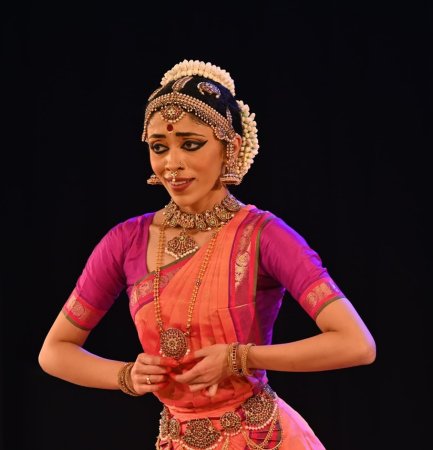 Divya Hoskere It was interesting to watch both teacher and student featured in the same festival as in the case of P. Praveen Kumar, whose disciple Divya Hoskere was also presented. With a pleasing stage presence, her Bharatanatyam rests on a sound framework of knowledge about the art form based on research. As in the manner of her teacher, she has a flawless movement profile while dancing. The varnam in Todi, Roopamu joochi, and the Meerabai Bhajan Mein Haricharanam ki dasi, in Yaman Kalyan, stood out. Praveen Kumar's nattuvangam with D.S. Srivatsa for vocal support, had N. Vidyashankar on mridangam, and flute and violin played by Mahesh Swamy and Nagaraj Mandya. 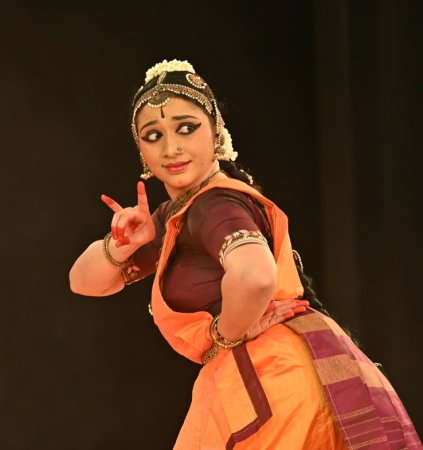 Meera Sreenarayanan One enjoyed the performance of Meera Sreenarayanan, who has been under Indira Kadambi's guidance for the last few years. Storming on to the Bharatanatyam scene a few years back, after a performance in Delhi which was disappointing, the performance of the varnam Sarasijakshudu nivani in Kalyani during this festival, for this critic redeemed her faith in this dancer's abilities. The call of the Nayika to Saundarya Gopala, the Dwarka Vasa, the keeper of her heart, interspersed with impeccably rendered jatis, rose to a climax in the charanam line Gaana vidya loludaina.., with Bijeesh Krishna's tuneful singing and Indira Kadambi's nattuvangam. Mridangam support by V.V. Charudutt with Easwar Ramakrishnan and N. Anantha Narayanan on violin and veena completed the accompaniments. Some comic relief as a contrast came in the Samvada pattu in Punnagavarali with Parvati ad Lakshmi trading words, each making fun of the other's consort! To round off was the Madurai N Krishnan Tillana in Simhendramadhyamam. TWOSOME ON SONG 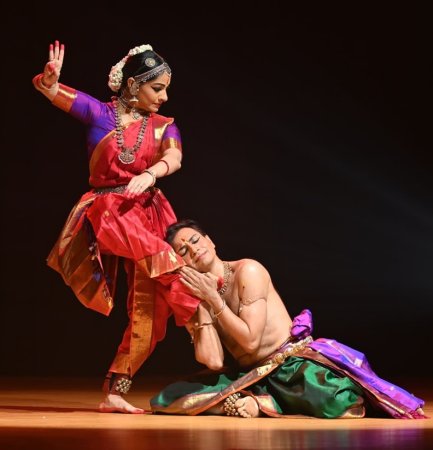 Shijith Nambiar and Parvathy Menon Always on song, Shijith Nambiar and Parvathy Menon as a twosome, have over the years, taken the duet form to a new high. Their choice of the Lalgudi Jayaraman Varnam in Neelambari Senthilnagar meivum Deva Deva, resulted in the philosopher/warrior God's unusual episodes taken from Skanda Puranam - for instance how the mango tree which was the form taken by Surapadman split in half by Skanda's vel had one half as the Peacock become Kartikeya's mount, with the other half becoming the rooster entrenched on his flag. For an international audience not familiar with our puranas, perhaps a short explanation in the introductions of the varnam and abhinaya pieces would help. The Thodi Utsava prabandam based on Swati Tirunal krithi was another fine item before the ashtapadi Kuru yadu nandana, which familiarly, has a solo dancer as Radha entreating the imagined Krishna to undo the dishevelment on her person - signifying regaining single individuality - before setting off again on the lila of seeking oneness with Krishna. With a duo, one has Krishna acting according to the wishes of Radha. With an experienced team led by nattvangam by Uday Shankar Lal and Binu Venugopal's vocal, were violinist Easwar Ramakrishnan and flautist Hariprasad. AGE HAS NOT WITHERED THE CHARM OF SENIOR DANCERS 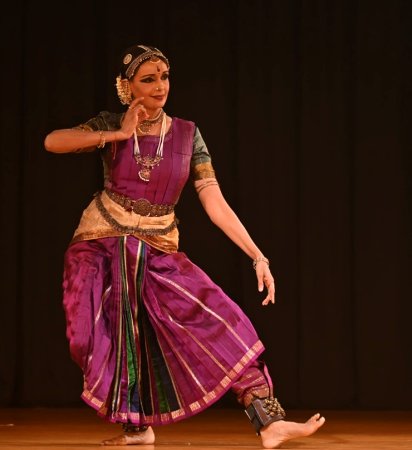 Priyadarsini Govind Priyadarsini Govind, her statuesque presence not a whit diminished with age, carries herself with the same grace. Movements tempered with perhaps less Mandi adavus and speed, are still grounded in a perfectly articulated araimandi central stance, with abhinaya conviction as strong as ever, evident in the Lalgudi Varnam in Charukeshi Innum en manam, followed by the Dashamukhi Slokam from Ashokavanikangam of Kutiyattam (set to Simhendramadhyamam raga in the music by Rajkumar Bharathi) portraying each of Ravana's ten heads voicing thoughts on Sita, in an individualistic manner expressing a variety of emotions - all underlined by the one uniform fact of unrequited desire for another's lawfully wedded wife. As is her wont, Priyadarsini in a flawless manner announced her own items. Led by Jayasree Ramanathan's spirited nattuvangam, was Muralisangeet V for vocal support, with mridangam played by S. Saktivel Muruganantham and K.R. Nandini on the violin. 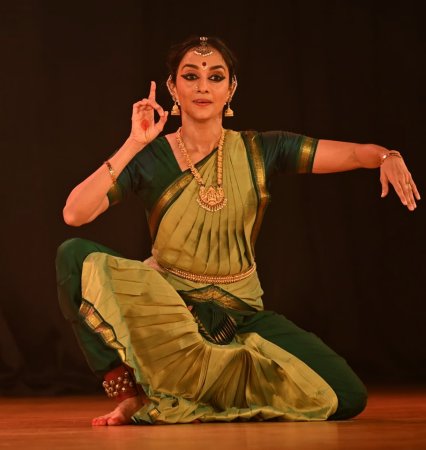 Lakshmi Parthasarathy Athreya Performing with vigor, was the other senior dancer Lakshmi Parthasarathy Athreya, a disciple of Chitra Visweswaran. Beginning with the Shakti Anjali in raga Mahati, a composition of Dr. Murali Parthasarathy, who provided vocal support for the recital, with Vidya Ravindran Anand conducting, the Ragamalika Varnam based on Bharatiyar's verses set to music by Rajkumar Bharathi, was followed by abhinaya reflecting the strong emotive appeal of a hurt Sita. How could your mind react thus, and with what sense of fairness do you mention leaving me behind, while you go to the forest for fourteen Years? (yeppadi manam tunindado) she demands of her husband. Have you forsaken the vows of constant companionship made during marriage? KATHAK WITH A DIFFERENCE 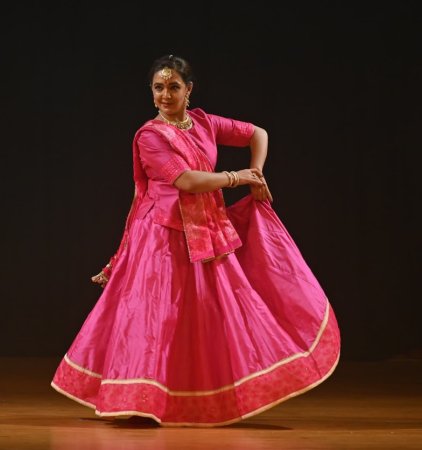 Divya Goswami Far from the usual Kathak virtuosity was Divya Goswami's presentation, bringing strong vibes of the stirring love story from the Punjab, in Aqeedat based on the original Sohni Mahiwal 10th century episode of love's union in the Divine - made immortal in the words of 19th century poet Syed Fazal Shah. Stemming from her family ancestor Pandit Kirpa Ram Sharma's poetic inspiration, and her Kathak Guru, Late Munna Lal Shukla's encouragement of new initiatives in his students, Divya is not afraid of venturing into unchartered areas. With a phulkari dupatta reminiscent of the Punjab, spreading her ghagra like an umbrella round her waist, Divya settles down on the floor, before a mike, briefing the Chennai audience less familiar with the Punjabi language of the poetry, with an outline of the story she intends presenting - with poet Syed Fazal Shah's words set to Hindustani music by Bangalore's Praveen D. Rao - the invocation in Yaman Kalyan set to Addha tal, before the story of Aqueedat unravels in a Ragamalika / talamalika. The story itself is of young Sohni married to a potter she does not care for, losing her heart to a herdsman of a lower caste named Mahiwal. Discovering her using a pot as a buoy to take her across the waters to the other bank to meet Mahiwal, Sohni is cruelly tricked by her sister-in-law, who breaking the pot, substitutes it for a still uncooked clay pot. Even as Sohni pleads with the pot "Mennu par karade" (please take me to the other shore) the pot melts away leaving her swallowed by the waters, along with Mahiwal who trying to meet her half way suffers the same fate and it is believed that the lovers are united with the divine even as the Jhelum waters flow on. Incorporating all the elements of Kathak in the narration, even as she takes on different roles with the central character of Sohni, Divya, a graceful, poised performer, has the fillip of supporting music, which provides an excellent take-off point, with singer Siddhartha Bellamannu's exquisite voice stealing the thunder, its bhav soaked melody imparting searing emotive power to the narrative. With Praveen D.Rao himself providing tabla support, and padhant (recitation of bols) by Keerti Kumar, Sameer Rao and Sarfaraz Khan provided flute and sarangi accompaniment respectively. My only disappointment was a small audience, albeit discerning, in the hall to watch such a performance. 7-45 pm - 9.15pm is not that late, that audiences cannot remain for a while to see what was in store in the non- Bharatanatyam hour and a half! NRITYAGRAM RINGS IN THE FINALE 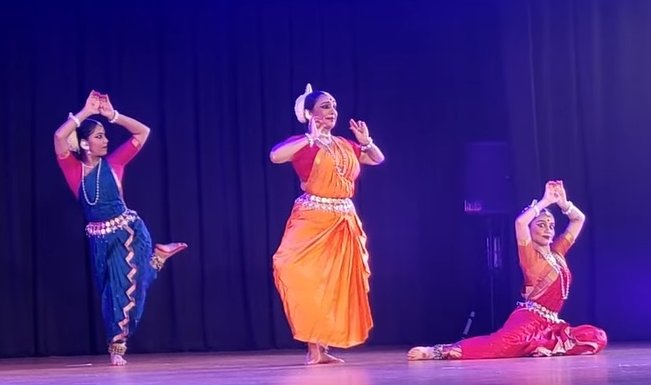 Nrityagram ensemble Some habits do not change, it would seem! One is that for years now, ringing in the finale for Music Academy's annual dance festival, has been the prerogative of the Nrityagram Ensemble. The other is that the music providing the spring board for Nrityagram's programs, in all these years, is surprisingly, still based on Late Pt.Raghunath Panigrahi's creations! It would seem that for choreographer Surupa Sen, who has been the lead conceptualizer for the ensemble for years, no other singer from Odisha has been found to live up to the genius of Pt. Raghunath Panigrahi, with whom she had established a unique rapport. Surupa's sharp feel for timing adds a special element of theatre to a performance, as experienced in the Sankirtanam curtain-raiser with a fervid prayer to Jagannath - starting with a jolt of a sudden awakening bang, ushered in with a strike of the large cymbals. The Ensemble, this year, presented young Anoushka Rahman, a sparkling dancer, showing exceptional talent, raising hopes of a great future! Srimati, a Pallavi Tarijhem in Ragamalika / talamalika set to Raghunath's music, is woven round the beauty of woman, and this has been choreographed in different ways over the years. This time the play on the words Arbuta Sundara having four dancers each exulting in her beauty in a different way, ringing in the ultimate query, 'Of what use this beauty unless offered to the Gods!' Set to Raghunath Panigrahi's music, the ashtapadi Pashyati dishi dishi rahasi bhavantam with the Sakhi trying to convince Krishna to visit Radha who in her home (vasa grihe) 'is wilting away in passion, fantasizing on you' in the past rendered by Surupa, met with a solo rendition by Pavithra Reddy, now the seniormost dancer in the troupe after Surupa. The unusual, abstract item Smritiranga like images from scraps of memory appearing and disappearing, visualized by Surupa Sen, resembled unconnected dream images flashing by. Set to raga Darbari and Ektali, it was an imaginative production which had a poetic quality- pictures assuming some kind of incoherent shape, but then vanishing even as you tried to hold them in the mind's eye. Based on an Oriya poem , Raghunath Panigrahi's music in raga Kirvani set to Ektali was on that prankster little Krishna. Ta kotha motte kahu na, Se nata nagara Kanha (Don't talk to me of that youngster, that Kanha - name for Krishna and also youngster - from Nata Nagara). Never has the melodic quality of the mardal percussion been so paramount as in Nrityagram's musical accompaniment. With Jatin Sahu's singing and harmonium and with Rohan Dahale's mardala, and violin and flute by Siba Nayak and Parshuram Das with manjira occasionally played by Surupa Sen, and with Lynne Fernandez's special lighting effects, the total effect was on a different plane. ENDOWMENT PROGRAMME CATAPULTS RARE TALENT 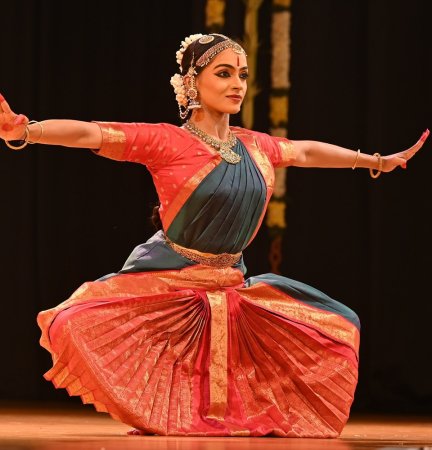 Aswathi K As if the seven day glut of dance presentations was not already creating a feeling of dance coming out of the ears, came the K. Chandrasekharan (former Vice President, Madras Music Academy) Endowment program Bharatanatyam Manjari, scheduled for the very next evening following the festival, presenting Aswathi K, a student of Shijith Nambiar and Parvathy Menon, who, as a famed duo, had been featured in the Academy's festival - and coincidentally been presented in the early stages of their career, in the same Bharatanatyam Manjari! To say that young Aswathi stormed her way into the audience hearts, would be putting it mildly, for here is a natural for the dance, who, if one had a say, would whole heatedly agree, catapulted herself straight into Academy's prestigious festival. The Varnam, a composition of T.R. Subramaniam in Behag set to adi talam, Vanajaksha ninne nammiti in praise of Venugopala, saw the dancer in her elements. Gifted with an extraordinary stage presence, and with the ability to lose herself in the emotive message of the composition, the young dancer also showed an uncanny feel for stage space making her cover the entire performance area with elan. With her guru Shijith conducting with his nattuvangam and Binu Venugopal providing melodic vocal support, the dancer's abhinaya created magic. Shijith's imaginative choreography was visible in the weaving of endless images of cowherd Krishna, like his drinking milk straight from the udder of the cow. And by the time of the charanam Sathile nee marakoti Sundara roopa, the audience in its mind's eye was swimming in images of Krishna more beautiful than countless Manmathas! If more proof of Aswathi's exceptional talent was needed, it came in the ashtapadi Sa virahe tawa deena with music set by Edepalli Ajit Kumar in Ahirbhairav. The song paints a picture of pining Radhika, as painted by the Sakhi addressing Krishna, asking for his immediate attention, for Radha wasting away pining for the Lord. What stood out in my mind was the line describing how Radhika is clinging to Madhava in her fantasy - vilapati hasati, visheedati rodati chanchai manchati - (laments, laughs, collapses, cries, trembles, utters her pain). Never have I seen this line so poignantly brought out in expressional performance as done by Aswathi. Lalgudi Jayaraman's Tillana in Rageshri ushered in the finale. Here is a dancer with unusual prowess, sensitively groomed by Shijith and Parvathy who must share the honours for the results. And last but not the least was the image of the child tanpura player (daughter of the Gurus) - seated without fidgeting and not wanting her name to be announced! Providing seamless sruti without jerks is an art in itself. Obviously, talent runs in the genes! 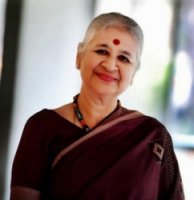 Writing on the dance scene for the last forty years, Leela Venkataraman's incisive comments on performances of all dance forms, participation in dance discussions both in India and abroad, and as a regular contributor to Hindu Friday Review, journals like Sruti and Nartanam, makes her voice respected for its balanced critiquing. She is the author of several books like Indian Classical dance: Tradition in Transition, Classical Dance in India and Indian Classical dance: The Renaissance and Beyond. Post your comments Please provide your name and email id along with your comment. All appropriate comments posted with name and email id in the blog will also be featured in the site. |